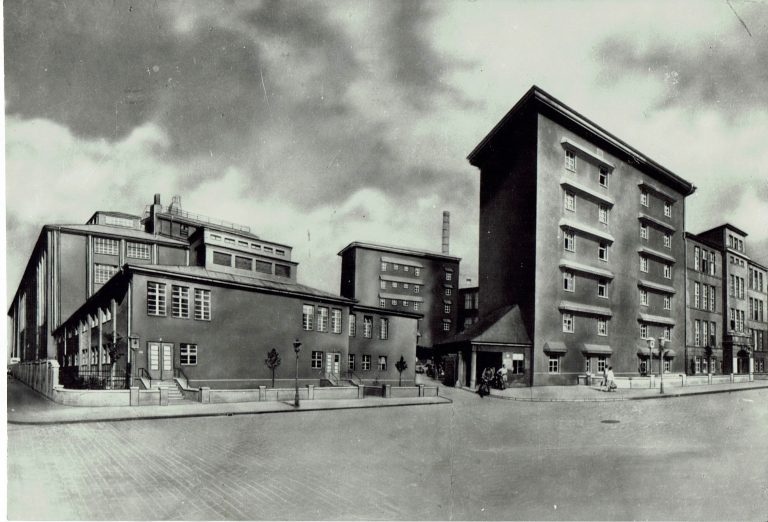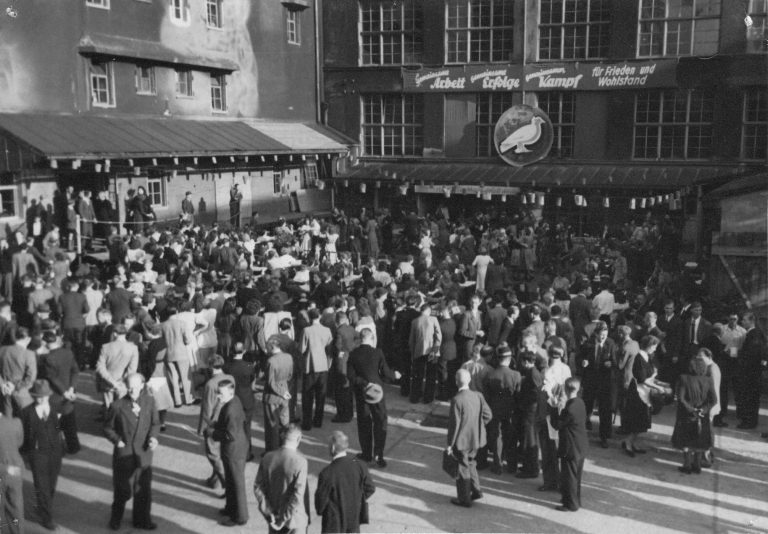- Preface 1 – The Zeiss-Ikon plant, in which a large number of the remaining Jews in the city work as forced labor, manages to retain its Jewish workers. Nevertheless, on January 21, 224 Jews from Dresden and nearby towns, including Paul Kreidl, are transported to the Riga ghetto…
On November 23, 1942, 279 Jews, the overwhelming majority of those left in Dresden who were not in mixed marriages or otherwise “privileged,” were forced to move to some newly erected barracks at Hellerberg, just outside the municipal boundary north of the city. The adults and adoles- cents of this group were largely employed at Zeiss-Ikon’s Goehle plant, which manufactured fuses for the German navy. **pviii - 1942 January 12, Monday – From to- morrow you’ll have work to do. The Goehle plant (Zeiss-Ikon). — Do you have problems with your heart?” — I was probably very pale and speak- ing laboriously, gasping for breath. Thus far the treatment had been al- most decent. Now another policeman appeared, perhaps one rank higher, average height, brown, mocking eyes. **p5
- 1942 January 17, Saturday – Different government departments appear to be at cross-purposes. The evacuation order appears to have originated from a Reich department and to have landed on Saxony without warning. The Zeiss-Ikon [ . . . ] factory is fighting for its Jewish section, which is working well. **p6
- 1942 January 19, Monday – The trial of strength: The Gestapo has struck twenty from the list of those reclaimed by Zeiss-Ikon, it has stopped transfers of workers from other companies to the plant. In total, 250 people will after all leave here on Wednesday. Among them Paul Kreidl…
… Seliksohn, early forties, Russian Jew by birth, came to Germany as a boy, volunteered in 1914 at 17 years of age, frontline service and interpreter in the East, afterward Social- ist and Zionist, ill-treated in a concentration camp, becoming diabetic, his wife at Zeiss-Ikon; both were on the transport list but were taken off it. **p8 - 1942, February 15, Sunday morning – Today we were supposed to go to the Seliksohns for tea. Called off, the wife’s father (Komblum) has died in a concentration camp, ashes forwarded. Was informed without warning in the Zeiss factory. **p15
- 1942 March 6, Friday – According to Katchen’s information from Zeiss-Ikon, where they always know everything, and sometimes it’s even true, the group is already going to be.. “deployed” again next week. **p24
- 1942 March 22, Sunday – Via Zeiss-Ikon, Katchen Sara reports new house searches and suicides. **p31
- 1942 March 25, Wednesday – Kreidl taken to a concentration camp. The women here in the house keep silent about it, the gossip headquarters at the Zeiss-Ikon factory knows all about it.**p33
- 1942 May 3, Sunday afternoon – At Zeiss-Ikon there is a “kindergarten” in the Jews’ section. Jobs that have to be done with a magnifying glass by very young eyes… **p47
- 1942 June 9, Tuesday morning – “How old are you? Why are you not working at Zeiss- Ikon?” — “Zeiss-Ikon is not taking anyone on at the moment.” — It all passed off not too badly; they left without any stealing, … **p70
- June 29, Monday morning – massive English air raids on Cologne and Bremen are supposed to be the prelude to an air offensive: “1,000 aircraft over north and central Germany!” Dresden is supposed to be among the marked cities. The flak positions here are being reinforced. (At Zeiss-Ikon and on the Town Hall.) **p89
- 1942 July 19, Sunday evening – very hysterical daughter, working at Zeiss-Ikon, would like to marry her elderly mother to an older fellow worker. (If one partner of a married couple works in an armaments factory, then supposedly they are not evacuated.) … **p103
- 1942 July 27, Monday morning …yet another similar case looming up, arrest of a man working at Zeiss-Ikon, Juliusburger, because he had “covered up the star.” — Murder is everywhere, reaching out for everyone… **p110
- 1942 August 6, Thursday morning – Katchen has been on the sick list for some weeks now and has not gone to Zeiss-Ikon. Her zeal has been cooled twice over, since she has been forbidden to take the tram and since it has become clear that even Zeiss-Ikon is no security against deportation. **p115
- 1942 August 14, Friday morning – A certain Juliusburger, in his fifties, at Zeiss-Ikon, was arrested a while ago for “concealing the star” and was thought to be a dead man. He has now been released after three weeks… **p120
- 1942 August 16, Sunday afternoon – Katchen Sara—and now she is even supposed to be getting permission to use public transport, which would take her back to Zeiss-Ikon and allow us to live alone for more than half the day.. **p123
- 1942 August 18, Tuesday morning – There has been a curious case at Zeiss-Ikon: It turned out that a woman wearer of the star was seventy-five percent Aryan. (Just as once it was discovered from time to time that a woman was male.) **p125
- 1942 September 6, Sunday midday – Her daughter, more sickly than Jewish in appearance, told us at breakfast in the kitchen this morning: It was so hard for her, she was remaining behind alone (worker at Zeiss-Ikon); her only sister was arrested in the spring… **p139
- 1942 September 8, Tuesday morning – One year ago Zeiss-Ikon had still employed 7,000 German workers; now only 500 Germans remained, the rest, the 6,500, had been replaced by foreigners, Russian, Polish, French, Dutch… **p141
- 1942 September 13, Sunday afternoon – After deportation of the old people has been completed, the Jewish section of Zeiss-Ikon will be evacuated… **p145
- 1942 September 15, Tuesday midday – Fraulein Hulda is a most loyal Aryan housekeeper, who has long been forbidden to help out here, who has been sent to do labor service at Zeiss-Ikon — she is well into her fifties — and who now stands by the Jewish tenants, just as she looked after Frau Jacoby until the last moment… **p146
- 1942 October 10, Saturday – A couple called Gelert, he a doctor, put in prison and then concentration camp for some trifle. Both deceased. Twin girls, sixteen years of age, working at Zeiss-Ikon, are left orphaned, poor and alone… **p143
- 1942 October 16, Friday evening – …Arrested therefore, and one must assume that when she came home she already knew something of her husband’s fate. He works in Reick, is building a “potato bunker” for Zeiss-Ikon… **p154
- 1942 October 23, Friday evening – From Katchen Voss (Zeiss-Ikon), from Frau Ziegler (Community), from Steinitz, whom I looked up yesterday for a sugar-tobacco exchange (wife’s Aryan relatives), from Frau Reichenbach, whom Eva looked after today (Community once again […]) come the following rumors: 1) The commander of the southern front. Field Marshal Bock, is said to have been recalled **p155
- 1942 October 29, Thursday toward evening – …He is now a foreman at Zeiss-Ikon. His wife does all the housework for the big family alone, gets up at four o’clock in the morning (her eldest is also already at Zeiss-Ikon), has to slave away till late at night. And is constantly worrying about husband and son. What happened to the Egers, and so many others, is at every moment hanging over her family… **p160
- 1942 November 4, Wednesday midday – Dreadful misery, proletarianization all around. The Eisenmann family. A little boy of three, a little girl of eight, a son of seventeen years of age. Blond, huge, like a strong Hitler Youth, but “brought up as Jewish,” wears the star, at Zeiss-Ikon. Frau Ziegler tells me that all five sleep in one room, are on top of one another in their kitchen-parlor… **p162
- 1942 November 13, Friday toward evening – …the Jewish workers at Zeiss-Ikon, about three hundred of the six hundred Jews still to be found in Dresden, are to be put in barracks… **p164
- 1942 November 19, Thursday morning – Zeiss-Ikon was in charge of the barracks, so things would be halfway human; also communication with the outside world would not be completely cut off. **p167
- 1942 December 19, Saturday morning – Eva sometimes teaches Herbert Eisenmann now, and he is often — as just now — up here to practice. And he talks then. He and his father work at Zeiss-Ikon. **p175
- 1943 January 17, Sunday midday – At the Zeiss-Ikon plant large numbers of Jews are being given notice. Half the (Jewish) workforce has already been given the sack. Previously the company resisted the Gestapo: **p190
- 1943 February 12, Friday evening – Herbert Eisenmann reported: The day before yesterday a certain Heil butt, an utterly decent man, had been arrested at Zeiss-Ikon during work. Reason unknown; **p199
- 1943 February 27, Saturday afternoon – “If only we could get at the mixed marriages!” I: “They don’t know anything either. They get their orders from Berlin.” — I got back at one very preoccupied. In the garden I met Eisenmann pere, who since dismissal from Zeiss-Ikon is still unemployed… **p204
- 1943 April 25, Easter Sunday morning – Katchen Sara talked about her “cousin” Conradi, who was working at Zeiss-Ikon —a famous man, but so anti-English, so anti-Semitic, almost Nazi. Thus I was all the more surprised to find… **p218


- Inside the building, image taken after 1945 (judging by the wall slogan), image credits www.zentralwerk.de
- History and current use of the site
- Zentralwerk (English)
- Stadtwiki Dresden (German)
Source:
- ** I Will Bear Witness, Volume 2: A Diary of the Nazi Years: 1942-1945, Victor Klemperer, Publisher : Modern Library; Illustrated edition
Purchase on Amazon: